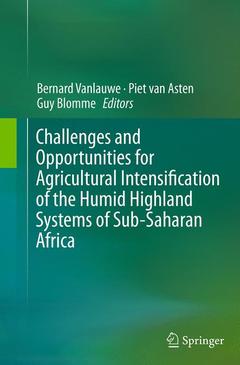Description
Challenges and Opportunities for Agricultural Intensification of the Humid Highland Systems of Sub-Saharan Africa, Softcover reprint of the original 1st ed. 2014
Coordinators: Vanlauwe Bernard, van Asten Piet, Blomme Guy
Language: English
Subjects for Challenges and Opportunities for Agricultural...:
Publication date: 08-2016
Support: Print on demand
Publication date: 10-2014
404 p. · 15.5x23.5 cm · Hardback
Description
/li>Contents
/li>Biography
/li>Comment
/li>
The humid highlands in sub-Saharan Africa (SSA) are characterized by high population densities and require intensification. The Consortium for Improving Agriculture-based Livelihoods in Central Africa (CIALCA) has set up a research for development platform in various mandate areas in DR Congo, Burundi, and Rwanda, aiming to identify improved production, market, and nutrition options and facilitating the access for development partners to these options. This platform is supported by capacity building, multi-stakeholder dialogue, and monitoring and evaluation efforts. The conference, facilitated by CIALCA, aimed to (i) take stock of the state-of the art in agricultural intensification in the highlands of SSA and (ii) chart the way forward for agricultural research for development in the humid highlands of SSA, and more specifically in the recently launched Humidtropics Consortium Research Programme, through keynote, oral and poster presentations, and strategic panel discussions.
Theme 1 – System characterization
Bridging the soil map of Rwanda with the ‘farmer’s mental soil map’ for an effective Integrated and Participatory Watershed Management research model; P.N. Rushemuka, J. Bizimana, J.J.M. Mbonigaba and L. Bock
Intensification of crop–livestock farming systems in East Africa: A comparison of selected sites in the highlands of Ethiopia and Kenya; M. Kindu, A.J. Duncan, D. Valbuena, B. Gérard, L. Dagnachew, B. Mesfin and J Gedion
Rapid assessment of potato productivity in Kigezi and Elgon Highlands in Uganda; G. Okoboi, I. Kashaija, R. Kakuhenzire, B. Lemaga and D. Tibanyendera
Farmers’ knowledge and perception of climbing beans-based cropping systems in Rwanda; V. Ruganzu, J. Mutware, B. Uwumukiza, N.L. Nabahungu, I. Nkurunziza and A.R. Cyamweshi
Securing crop phosphorus availability in the humid tropics: Alternative sources and improved management options - A review; A.S. Jeng
Theme 2 – System components
A decade of agricultural research in Rwanda: Achievements and the way forward; D. Gahakwa, T. Asiimwe, N.L. Nabahungu, M. Mutimura, T. Isibo, A. Mutaganda and C. Ngaboyisonga
Do commercial biological and chemical products increase crop yields and economic returns under smallholder farmer conditions? J. Jefwa
Enhanced utilization of biotechnology research and development innovations in eastern and central Africa for agro-ecological intensification; C.W. Masiga
Investing in Land and Water Management Practices in the Ethiopian Highlands: Short- or Long-Term Benefits? Y.G. Selassie and T. Amede
Yield responses of cowpea (Vigna unguiculata) varieties to phosphorus fertilizer application across a soil fertility gradient in western Kenyan highlands; S.N. Odundo, O.J. Ojiem, J.R. Okalebo, C.O. Othieno, J.G. Lauren and B.A. Medvecky
Innovations to overcome staking challenges to climbing beans production by smallholders in Rwanda; A. Musoni, J. Kayumba, L. Butare, F. Mukamuhirwa, E. Murwanashyaka, D. Mukankubana, J.D. Kelly, J. Ininda and D. Gahakwa
Crop–livestock interaction for improved productivity: Effect of selected varieties of field pea (Pisum sativum L.) on grain and straw parameters; G.G. Yetimwork, E.G. Awet and M. Solomon
From standards to practices: The intensive and improved rice (SRI and SRA) systems in the Madagascar Highlands; G. Serpantié and M. Rakotondramanana
Identification of elite, high yielding and stable maize cultivars for Rwandan mid-altitude environments; C. Ngaboyisonga, F. Nizeyimana, A. Nyombayire, M.K. Gafishi, J. Ininda and D. Gahakwa
Determination of appropriate rate and mode of lime application on acid soils of western Kenya: targeting small scale farmers; J.K. Kiplagat, J.R. Okalebo, C.K. Serrem, D.S. Mbakaya and B. Jama
Assessment of fertilizer efficiency in Walungu weathered soil on maize yield; M.E. Bagula, P. Pypers and N.G. Mushagalusa
Improvement of sweetpotato (Ipomoea batatas (L.) Lam) production with fertilizer and organic inputs in Rwanda; M. Janssens, V. Rutunga, J. Mukamugenga, S. Mukantagengwa and R. Marijnissen
Evaluation of sweetpotato varieties for the potential of dual-purpose in different agroecological zones of Kenya; B.A. Lukuyu, J. Kinyua, S. Agili, C.K. Gachuiri and J. Low
Theme 3 – Drivers and determinants for adoption
Livelihoods heterogeneity and water management in Malawi: policy implications for irrigation development; T.J. Kopa-Kamanga, D.J. Kjosavik and P.S. Kamanga
Access to subsidized certified improved rice seed and poverty reduction: evidence from rice farming households in Nigeria; B.A. Awotide, T.T. Awoyemi and A. Diagne
Factors influencing the adoption of improved rice varieties in Rwanda: An application of the Conditional Logit Model (CLM); J.S. Mutware and K. Burger
Assessing the influence of farmers’ field schools and market links on investments in soil fertility management under potato production in Uganda; R. Muzira, B. Vanlauwe, T. Basamba, S.M. Rwakaikara and C. Wanjiku
Bean utilization and commercialization in Great Lakes region of Central Africa: The case of smallholder farmers in Burundi; J. Ochieng, M.C. Niyuhire, C. Ruraduma, E. Birachi and E. Ouma
Enhancing farmers’ access to quality planting materials through community-based seed and seedling systems: Experiences from the Western Highlands of Cameroon; B. Takoutsing, A. Degrande, Z. Tchoundjeu, E. Assah and A. Tsobeng
Returns to production of common bean, soybean, and groundnut in Rwanda; J.R. Mugabo, J. Chianu, E. Tollens and B. Vanlauwe
Theme 4- Knowledge-intensive approaches
Beyond the pilot sites: Can knowledge-intensive technologies diffuse spontaneously? E. Kiptot
Agricultural innovations that increase productivity and generates incomes: Lessons on identification and testing processes in Rwandan agricultural Innovation Platforms; C. Ngaboyisonga, J. Mugabo, B.S. Musana, M.M. Tenywa, C. Wanjiku, J. Mugabe, F. Murorunkwere, S. Ntizo, B. Nyamulinda, J. Gafaranga, J. Tuyisenge, S.O. Nyamwaro and R. Buruchara
ISFM adaptation trials: farmer-to farmer facilitation, farmer-led data collection, technology learning and uptake; B.K. Paul, P. Pypers, J.M. Sanginga, F. Bafunyembaka and B. Vanlauwe
Consortium for Improving Agriculture-based Livelihoods in Central Africa (CIALCA)
Agricultural Research for development in the humid highlands of sub-Saharan Africa
Research for development platform in various mandate areas in DR Congo, Burundi and Rwanda
Includes supplementary material: sn.pub/extras




